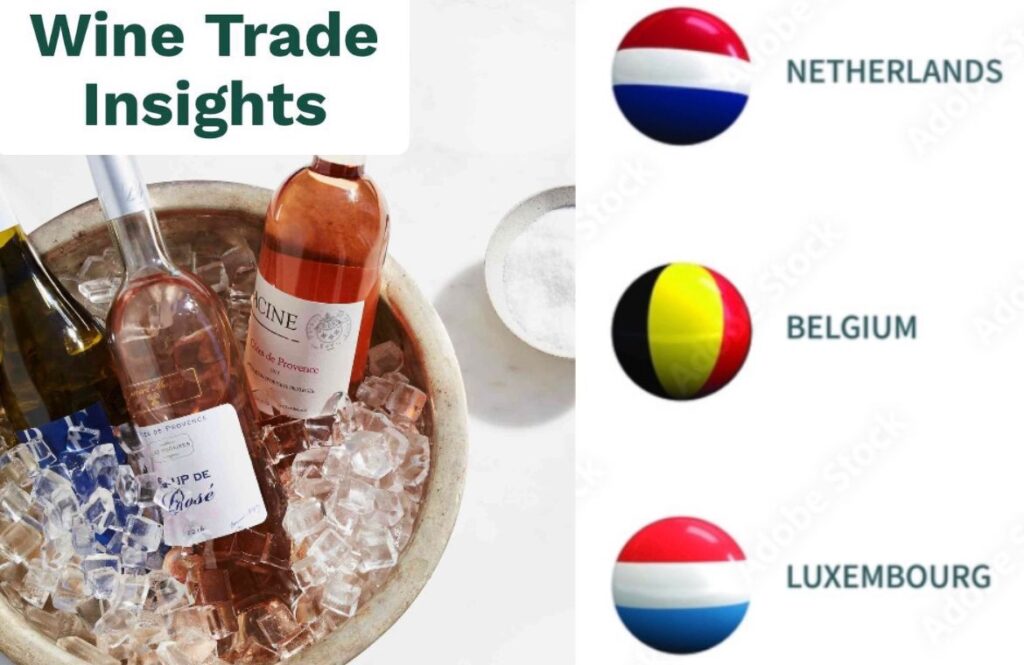When wine professionals think about the major players in global wine trade, the spotlight often falls on large markets like the United States, the United Kingdom, Germany, or China. Yet nestled in the northwest corner of Europe, the Benelux region—Belgium, the Netherlands, and Luxembourg—quietly plays an outsized role in the import, distribution, and re-export of wine across the continent.

Despite their small size, the Benelux countries act as a vital commercial gateway to Northern and Western Europe. With world-class port infrastructure, sophisticated logistics networks, and evolving consumer markets, they serve both as a landing pad for international producers and as a springboard for broader European access. For exporters looking to scale into Europe strategically, understanding the dynamics of Benelux isn’t optional—it’s essential.
A Strategic Entry Point for Global Wine
The Netherlands and Belgium import more than a billion liters of wine annually, with much of that volume redistributed to other EU countries. The Port of Rotterdam, Europe’s largest and one of the busiest in the world, plays a critical role in facilitating bulk and bottled wine shipments from France, Italy, Spain, Chile, South Africa, and Australia. Antwerp is also a key hub, especially for French and German wine traffic.
For producers outside the European Union, particularly those in the Southern Hemisphere, the logistics efficiency and centrality of Benelux make it an attractive entry point. Wines can be cleared, warehoused, repackaged, and distributed with relative ease to key European retail and horeca (hotel/restaurant/catering) markets from a single location. In effect, Benelux functions as Europe’s wine roundabout.
Evolving Consumer Markets
Consumer behavior in the region is also shifting—becoming more diverse, digital, and sustainability-conscious. In Belgium, traditional preferences for French wine remain strong, but there is rising interest in organic and biodynamic wines, particularly among younger urban consumers. Italian whites and Spanish reds have gained notable traction, driven by competitive pricing and modern branding.
The Netherlands, meanwhile, has emerged as one of Europe’s most progressive wine markets. Dutch consumers are increasingly drawn to low- and no-alcohol options, natural and vegan wines, and sustainable packaging formats such as cans and lightweight bottles. E-commerce continues to gain ground, fueled by digital-savvy consumers who often discover wine via social platforms or digital subscriptions.
Luxembourg, though much smaller, remains a high-value niche market. Its affluent consumers favor premium French and German wines and show a strong interest in terroir-driven offerings.
Price Sensitivity Meets Premiumization
One of the paradoxes of the Benelux region is the balance between price sensitivity and the demand for premium, niche wines. While many consumers seek value—especially in supermarket channels—there is also clear momentum toward wines with a compelling story, sustainable practices, and regional authenticity.
Importers in the region are increasingly looking for unique offerings that combine quality, transparency, and logistical flexibility. Producers who can offer smaller lots, tailored labeling, or storytelling assets such as QR codes or digital traceability tools are finding receptive partners.
The Re-Export Effect
Perhaps one of the most underappreciated aspects of the Benelux wine trade is its re-export function. A significant percentage of the wine imported into the Netherlands and Belgium does not stay there. Instead, it is redistributed to neighboring countries, including Germany, Denmark, Poland, and the Scandinavian markets.
Dutch importers often work with regional supermarket chains or distributors across borders, while Belgian brokers and wholesalers serve as key intermediaries for both traditional and emerging markets. This makes Benelux not just a consumption zone, but a powerful hub within the European wine trade network.
Looking Ahead
Several key opportunities are emerging across the Benelux landscape. The low- and no-alcohol wine category is expanding rapidly, outpacing supply in some cities. Sustainable and certified organic portfolios are no longer niche—they are becoming the expectation in many retail channels. Ecommerce-ready SKUs and wines with compelling digital storytelling are also gaining traction, particularly among millennial and Gen Z consumers.
In the logistics arena, premium bulk wine and private-label solutions are on the rise, especially in the Netherlands. For producers with flexible production models, this represents a growing path to volume and visibility.
Conclusion
The Benelux region may be modest in geographic size and population, but its impact on the global wine trade is anything but small. As both a consumer market and a logistical gateway, Belgium, the Netherlands, and Luxembourg offer a unique combination of access, efficiency, and sophistication.
For producers, brokers, and trade professionals looking to expand into or across Europe, engaging with Benelux isn’t merely an option—it’s a strategic advantage. In a wine market increasingly shaped by agility, sustainability, and storytelling, the region stands as a model of modern wine commerce: compact, connected, and quietly powerful.